China Trip 2004
October 20th - November 2nd
For 13 days a small group from WuTang Ohio visited China, competing in The Fifth International Traditional Chinese Martial Arts Tournament in Qingdao, and seeing the sights throughout Shandong Province.
DAY 1
FLY TO
BEIJING, CHINA
Beijing, a city of 14 million, is rapidly developing in preparation
for the 2008 Summer Olympic Games.
DAY 2
FLY TO
QINGDAO, CHINA
Shandong Province
Qingdao, population 7 million, is the largest city in Shandong
Province.

A view of the tournament site from the hotel's revolving restaurant
Tsing
Tao #1 Brewery Tour
The Tsing Tao #1 Brewery and bottling plant has highly upgraded
its tour over the past few years. While tours have nearly always been offered
(except on Sundays or during periods of renovation) none in the past can compare
to the multimedia extravaganza now offered. The original buildings constructed
by the Germans in 1903 are now open as a museum. Inside are numerous old photos,
advertising posters, and various old Tsing Tao Beer relics and memorabilia.
Also inside is the original brewing equipment. In addition there is a small
old style pub where free tasting occurs. In the bottling plant there is another
display hall with modern exhibits, awards from the 100 year anniversary, and
the Movie. The Movie screen is two stories tall, the theater has booming surround
sound, and the floor moves! As you watch a movie that puts you in the place
of a bottle in the plant, the floor tilts and shakes as you are sent down
the line, around tight curves, filled with beer, capped, boxed, and shipped
by truck to a rockin' party!
The Fifth
International Traditional Chinese Martial Arts Tournament
Welcome
Banquet hosted by the Mayor
We had the chance to meet the other teams and have pictures
taken with the Mayor. We sat with Mario Mandra (Italy) and his team. We also
had the pleasure to meet and get to know Frank Miller (Fujian).

DAY 3
The Fifth
International Traditional Chinese Martial Arts Tournament
The tournament site was
the squat circular building in the foreground of the above picture. It is
actually the Tsing Tao Beer Hall where the annual Beer Festival is held. It
is surrounded by Tsing Tao World, a theme park open during the Festival.

Opening Ceremony and Competition
Begins
Qingdao Beach Walk

The Qingdao Sculpture Park extends along the beachfront for
miles. This large red sculpture in Wu Si (May 4th) Square is the most widely
recognized. There are many others in Musical Square, the Sculpture Garden
and along the Stone Pillar Walk.

DAY 4
Competition Continues
Masters Demo
Closing Ceremonies

Master Su, "The Chinese Picasso" Yue Shi, Zhang Wei
Fu and Master Yang hold the newly penned "Wu"

Master Yang receives his
award

Zhang Wei Fu, Officials and Organizing Committee Members
DAY 5
Early trip to the Park
Meet Taiji Master on TV
Wei Ping comes to take
us to Jinan
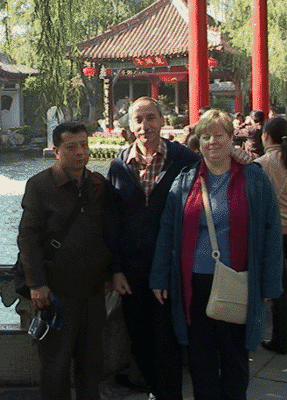
Wei Ping Zheng with Ralph and Loreen
Stop in Zibo
This city is made up of eight districts and counties. Each
district has rural countryside surrounding it. It is said that Zibo has the
largest area of all the cities of China, if these rural areas are counted.
The city has a population of 4 million.
Sacrificial Horse Graves of the Eastern Zhou Dynasty

This site is located in
the Northeastern section of what was once the capital of the Kingdom of Qi.
Many nobles had their tombs in the area during the Spring and Autumn Period
(722 BC-481 BC). More than twenty medium and large size tombs have been excavated.
This is one of them.
This particular pit is only one-sixth of the entire tunnel. It is 12m wide
and 18m long.
It was unearthed in 1964. There are 145 horses buried in it. The tunnel surrounds
Qi Jing Gong's grave. Jing Gong was the 25th generation among the monarchs
of the ancient Kingdom of Qi. He lived in the late Spring and Autumn Period
and occupied the throne for 58 years, from 547 BC-490 BC. He was said to have
been fond of building places, gathering dogs and horses and living in luxury
while carrying out oppressive taxation and severe punishment.
DAY 6
Jinan
Jinan, capital of Shandong Province, has a population that
now stands at 5.5 million. It has been known for centuries as the "City
of Springs". Legend says there are 72. An actual count is hard as many
of the over 100 springs have dried up in recent years, due to increasing industrial
use of underground water and prolonged droughts.
Jinan Tour:
Baotuquan Springs

Baotuquan Springs have been the source of the Le River for
over 2700 years
Da Ming Lake Park


Si Men Ta

Four Gate Pagoda is located on the Qinglong mountain,
33km (20 miles) southeast of Jinan. It is one of the oldest stone pagodas
in China, dating back to 611 AD. There are 4 arched doorways on each face
of the square structure, each containing one of four beautiful Buddhas. The
pagoda is 15 meters (49ft) high and is still in good condition.
Calligraphy by Yue Zuo
Quan 
![]()

"Hu Guang Shan Se" - Bright Lake,
colorful
Mountains
DAY 7
1000 Buddha Mountain


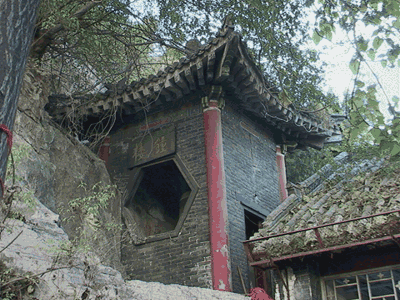
Shangdong Provincial Wushu College

Zhang Wei Fu, Zhang Lian
Deng (President of Shandong Wushu College) and Master Yang

Zibo Ceramic Factory
The city of Zibo in Shandong Province has been known as the “Ceramics Capitol” since ancient times. According to historical record and archaeological evidence, it began to produce ceramics 8000 years ago. Today, ceramics has developed into Zibo's pillar industry with over 300 ceramics enterprises and nearly 100,000 employees. Zibo is known to the world for its production of building and industrial ceramics, and household porcelain ware. Located in the middle of Shandong Province, Zibo governs 5 districts (Zhangdian, Boshan, Zichuan, Zhoucun and Linzi) and 3 counties (Huantai, Yiyuan & Gaoging), forming a city group with town interspersed by country. Zibo is seventy kilometers away from Jinan and 295 km away from Qingdao. It covers an area of 5938 square kilometers with a total population of 4 million.
A Top Tourism City
Zibo is rich in tour resources because of its long history and geographical
location. It is one of the five major tour regions of "Shandong Province
- Qi Culture" tour region. It used to be the capital of the ancient Qi
state between 11th century BC and 221 BC, making it the birthplace of Qi culture.
In this area so many historical sites and cultural relics are found that it
is described as “an underground museum.”
DAY 8
Qufu Tour:
Confucius Temple
Confucius Mansion
Confucius Forest (Graveyard)

Standing outside Apricot Pavilion
The ancient Chinese philosopher Confucius (Kong Fu Zi) lived from 551 to 479BC. His home and gardens were made into a temple in 478BC, the year after his death. It is one of the three most important temples in all of China. We visited Qufu, the ancient capital of the Kingdom of Lu. Here we saw the 3 Kongs. In Confucius Temple (Kong Miao) we stood in the Apricot Pavilion (Xing Tan), where Confucius taught his students. We toured Confucius Mansion (Kong Family Mansion) where his decendents lived for thousands of years. Confucius was buried nearby in Kong Lin, the largest family cemetery in China. There are various stone guardians near the grave site. Below is a picture of the Wen Bao, a mythical beast with knowledge of all languages.

Taishan

Mt. Tai (Taishan) is the most sacred of the five sacred mountains of China. It has been visited by 72 Emperors of successive Dynasties. The mountain is covered with temples and scenic vistas. Here we saw Bixia Temple built in the Song Dynasty, one of the three most important temples in all of China. We also saw Duguan Peak where the trip made by Emperor Xuanzhong is recorded in stone, 13.3 meters high with 996 characters written by the Emperor himself.

DAY 9
Jinan Shopping

#2356 The Most Excellent Waitress in ALL of China!
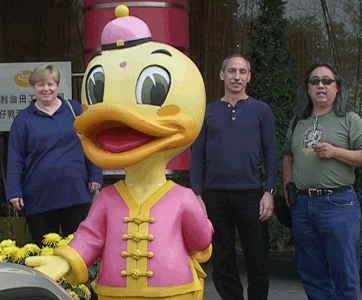
Jiangzaiya Restaurant
- Very good food, Excellent service
Late Overnight Train to Beijing
DAY 10
Forbidden City (Imperial Palace)
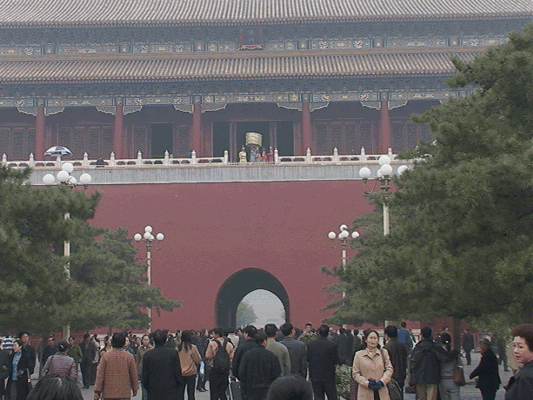
An Empress addresses the crowd

Forbidden fruit in The Forbidden City

#1 Dragon Son (on 9 Dragon Wall)
Lunch with Master Su

DAY 11
Badaling Section of the Great Wall
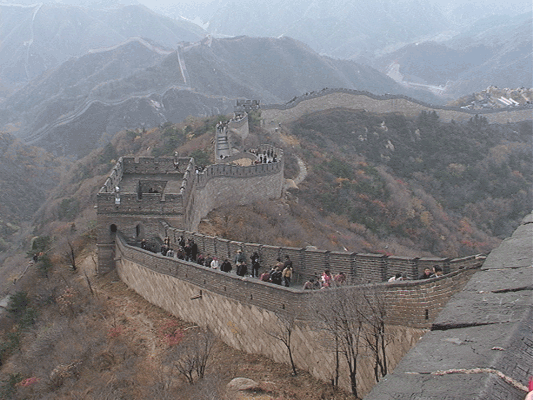

Master Yang's Keychain Souvenir
Lunch at The Hard Rock Cafe
DAY 12
Beijing Subway at Morning Rush

Marco Polo Bridge

Lugouqiao southwest of Beijing
Construction of The Marco
Polo Bridge (or what is called Lugou Qiao in Chinese), was first started in
1189 and finished in 1192, during the Jin Dynasty. It is the oldest multi-arched
stone bridge still existing in the Beijing area. In the year 1275, nearly
730 years ago, Marco Polo crossed this bridge. He later described it in his
book of world travels thus introducing it to Europe and the Western World.
It is 266.5 meters long, 7.3 m wide, with 11 arches, 10 piers, and over 500
carved lions, large and small. The stone lions were carved in the Jin, Yuan,
Ming and Qing Dynasties. On July 7, 1937 it was the sight of what became known
as the Marco Polo Bridge incident, a clash between Chinese and Japanese troops
which started the Sino-Japanese War (1937-45). Following the Marco Polo Bridge
incident, the Japanese prime minister Prince Fumimaro Konoye, embarked on
an undeclared war that would continue until 1945. Like dominoes the important
cultural & financial cities of China fell to the Japanese, including Beijing
on July 28, 1937.




Vegetarian Lunch

Beijing Shi Fang Vegetarian Restaurant
It took a bit of effort to find the place, but it was well worth it. It was probably the best meal we had the whole trip. The food was good, the service excellent and the decor phenomenal. The entire two-story complex was done in a Tibetan motif. There were stone elephants outside guarding the doors, Tibetan Buddhist artwork hanging on the walls and a giant carved Buddha on the way up the stairs. The head manager showed off the place and then we stopped to take one last picture.
DAY 13
FLY HOME
documented
and published WED, Nov. 10, 2004